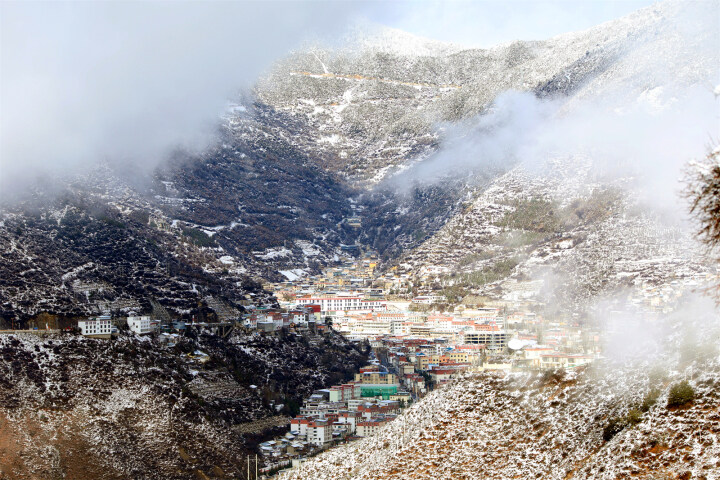To alleviate poverty, Xixi village in the Aba Tibetan and Qiang autonomous prefecture began to move its herdsmen to Daqinggou in early 2016. In the following year, 99 Tibetan-style dwellings were completed, and the area was equipped with a kindergarten, tap water and 4G network. Due to the improved living conditions, Samai, a middle-aged herdsman in the village in Southwest China's Sichuan province, no longer need to run errands on horseback. "Previously, my house was in pasture and built with mud, 15 kilometers away from the township government," Samai said, adding that he had to go out and transport goods on horses and yaks. Now, Samai rides a motorcycle - on cement roads - to visit the township. 
Left and right: Countryside view in the Aba Tibetan and Qiang autonomous prefecture. Provided to China Daily; children in Aba play in their new school. Wu Paiyong / For China Daily 
Local residents in Aba harvest crops. Provided to China Daily Xixi village has an average elevation of more than 4,000 meters and is located in a zone of transition between high mountains and grassland. Because of the area's vast territory and sparse population, infrastructure could not cover all 114 households, which were separated by mountains and gorges.
In the past, a village official said, old people had to be carried to visit doctors. The network signal was weak, and to hold a villagers' meeting, officials would have to separately notify residents a few days in advance. Yaks are the only income source for Xixi village. The official said the village integrated industrial development capital worth 528,500 yuan ($78,800) and founded a partnership pasture to scientifically breed yaks. Per capita income of poor households can increase by 400 yuan annually. The village also benefited from Rangtang county's poverty alleviation policy related to ecological protection. Some poor villagers were chosen to work in forest management and protection. About 90 percent of the village area is forest or grassland, the highest among villages in Rangtang, and 33 poor herdsmen have become forest rangers. One of them said she patrols forests every two days and gets a salary of 550 yuan monthly. Jin Dong, head at the poverty alleviation and development bureau of Aba, said the prefecture lifted 208 villages and 17,000 people out of poverty in 2018; in 2019, it plans to lift 33 villages and 4,862 people out of poverty. It also wants to further improve life for the 99,300 people that have already seen their incomes rise above the poverty line, Jin said. The prefecture will make tourism and husbandry its main industries for poverty alleviation. Jobs related to ecological protection and export of labor service will be stable employment channels. It will offer public and basic service guarantees to all the villages, improving water and electricity supply, road conditions, communication and housing. Scenic area crammed with resources The Aba Tibetan and Qiang autonomous prefecture is located in northwestern Sichuan and the southeast side of the Qinghai-Tibet Plateau. It covers an area of 84,200 square kilometers with a population of 920,000. It is the second-largest Tibetan region in Sichuan province and a major area inhabited by the Qiang ethnic group. Aba is endowed with a wonderful landscape. It boasts three of the world's natural heritage sites such as Jiuzhaigou and Huanglong, 10 national forest parks, five national wetland parks and 25 natural reserves. It was praised by world travel experts as one of the world's best ecological tourism destinations. Aba is also a corridor of ethnic culture, housing blockhouse-shaped buildings of the Tibetan and Qiang ethnic groups that are prized as models of stone buildings. Aba abounds in resources and is a water reservation region in the upper reaches of Yangtze and Yellow rivers. It has minerals such as gold, uranium, lithium, silicon and iron and grows premium and rare fruits. It is one of China's five major pastures and is known as a natural drug store, being home to more than 1,900 kinds of traditional Chinese medicine materials. Aba has changed greatly since it was founded more than six decades ago. Its GDP has increased from 24 million yuan in 1952 to 30.4 billion yuan in 2018 and its road mileage exceeds 13,000 kilometers. Last year, the prefecture's farmers and herdsmen saw their net income reach 12,920 yuan per capita; the number of schools rose from 245 just after the prefecture's foundation to 676. In the beginning, the prefecture only had six medical clinics and 25 medical workers. By late 2018, it was home to 1,682 health agencies and more than 7,000 health personnel.
|







7740f3b5-9ecb-438e-9052-76cb2d4bb671.jpg)

